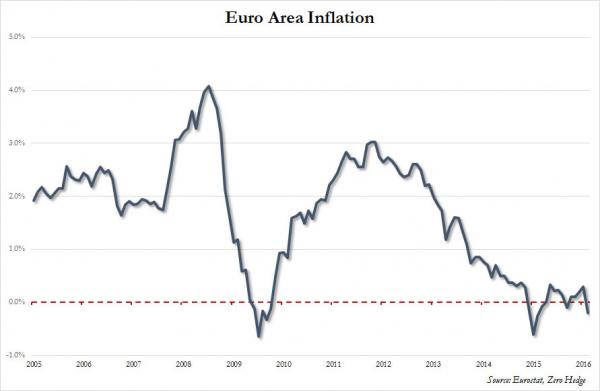A little under one year after the ECB launched its own QE of €60 Billion/month in bond purchases in early March 2015, a process which has resulted in the ECB monetizing over €670 billion in European – mostly German – sovereign paper, moments ago Eurostat reported European February inflation (even though the month is not over yet), and it was a shock, with headline inflation tumbling form +0.3% Y/Y in January to a depressing -0.2% in February, the worst print since January 2015. It was expected to drop to “only” 0.0%.

Â
The decline is largely due to a big decrease in energy costs, which were 8 percent lower in the year to February against the previous month’s 5.4 percent drop. However, the core rate, which strips out the volatile items of energy, food, alcohol and tobacco, was weak too, falling to 0.7 percent from 1 percent. That shows how weak price pressures from such things as higher wages are in the eurozone economy.
And here comes the paradox: as the AP reports, this disturbing report will boost expectations that the European Central Bank will unveil another stimulus package at its next policy meeting on March 10.
So, since Europe’s annual inflation is now lower than the month it launched QE, the “only logical response” is to do even more: as AP wryly observes, “since the ECB aims for inflation just below 2 percent, February’s negative rate could mean it cuts interest rates further or expands its bond-buying program — inflation has been below target since February 2013.”
“Poorly anchored inflation expectations and the cooling economy will prompt the ECB to ease already-accommodative monetary policy,” said Tomas Holinka, economist at Moody’s Analytics. Ah yes, because it wasn’t ECB’s already accommodative policy that unleashed the global currency war which has resulted in global inflation expectations, and not to mention rates, plunging to record lows and pushing over $6 trillion in debt into negative rate territory.

